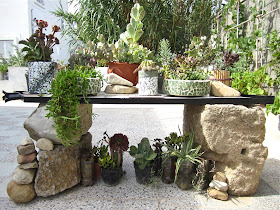I dressed up my sewing machine a bit in honor of Rosie, who has been on my mind recently.

For those unfamiliar with that World War II poster girl icon, Rosie the Riveter, here's the original image by J. Howard Miller. This poster was used to persuade 6 million women to go to work in the armament and aviation industries when men marched off to war. The patriotic red, white, and blue tells the viewer to serve the country in its time of need. It was a very successful propaganda campaign indeed.
Rosie's image seems to appear frequently these days and came to mind when I wanted to express an idea about my sewing machine that had nagged at me for awhile. And so, Tessie the Tailor, Rosie's sister, came into existence.
First of all, what's in a name? The name contains the hard consonants of R, S, and T that suggest masculinity while the "ie" of Rosie brings it back towards the feminine. However, "the Riveter" carries strong connotations of masculinity. Consider other aspects of the image:
Feminine Traits Masculine Traits
1. red scarf 1. blue working clothes
2. a few escaping curls 2. black hair (a harsh color)
3. red cheeks 3. square, firm jaw
4. small nose 4. firm chin
5. shaped eyebrows 5. black eyebrows with a no-nonsense expression
6. mascara 6. black eyelashes emphasize the hard, no-nonsense look
7. lipstick on full lips 7. lips turned down at the corners
8. one well-manicured fingernail 8. the hand is very large
9. --- 9. a muscled arm that has the sunburn of a worker
10.--- 10. The flexed arm that ends in a hard fist
11.--- 11. The figure itself is not elongated or elegant, but
rather broad and stocky.
12.--- 12. Thick neck.
At this point, the scales tip toward the masculine and one may wonder whether Rosie was a man or a woman. It's not that women don't have traits listed on the masculine side. There are women with strong chins and square jaws, like me, for example. However, the sum of the male traits gives an overwhelming impression of masculinity.
In addition, the power establishment was only letting women into the work force as lowly workers. There is no suggestion of possible promotions, career, or any sort of professional aspirations. Women were going to give a hand--temporarily.
Obviously, the artist was a male and, consciously or unconsciously, created an image that told women they had to be more than they were; to be a woman was inadequate. Looking around at representations of women in the media today, I'm not sure we've made much progress. We must remain vigilant.
Come to think of it, I'm not sure I want Tessie the Tailor
representing MY sewing machine at all!









